Don't wanna be here? Send us removal request.
Text
Consolat de Mar

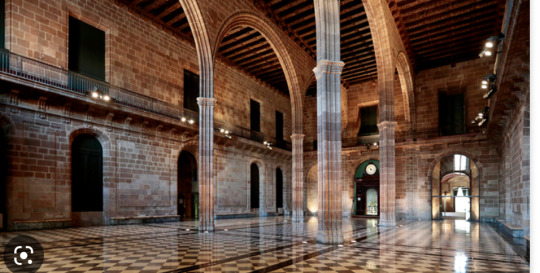
In English, it translates into the consolate of the sea. It is now the center for commerce, industry and navigation. It was made to regulate trade run by the Consuls of the Sea for sailors and merchants.
0 notes
Text
Main Changes in Catalan Society
After September 11th, 1714 the decrees of Nova Planta were proclaimed in Catalonia by Philip V. The main problems in the Catalan society during the rule of Philip V. were the restrictions on the Catalan language, and religion. Catalans were restricted a lot under the rule of Philip V and had very little rights. After September 11th, 1714 it was the last time the independence was lost for the Catalan culture. Today, the Catalan culture is still trying to get total freedom from the Royal family in Madrid. September 11th is celebrated in Barcelona and a big event to celebrate.


0 notes
Text
Cultural Relation and Symbolism
Santa María del Mar: Pure gothic style, for the people in the neighborhood (port workers). It was built to honor the conquest. It was built by the help of people in the community.

El Mercat del Born: The market was the first use of iron in Barcelona. It was the old fish market and then a fruit and vegetable market. It closed in 1971. It is now a culture center with the remains from the war of succession.

El Fossà de les Moreres (war of succession ended): This was built on an old cemetery, where a lot of the people were killed after the war of succession. It is now a square near Santa María del Mar.

La ciutadella Park (The Fortress of Philip V by 1714): Philip V made the ciutadella park which was the largest fortess of the time. It has 5 corners which helped with defense and was able to protect the area. Today, there are lots of stuff to do in La Ciutadella park such as a Zoo, renting a boot in the lake or just hanging out in the park.


0 notes
Text
Observing Buildings in Barcelona
The Port is a big change in Barcelona. The old port was where Port Vell is today. It is still there today and made into a tourist spot. The new port was moved as seen where the cruise ship is on the right.
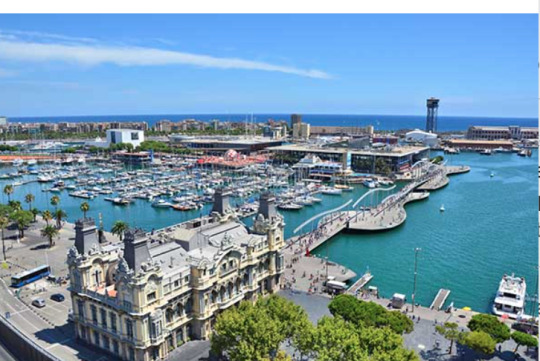

Another change is the area of Poblenou. It went from an agricultural land to an industrial center to now a neighborhood for young people. There are still preserved buildings that keep the industrial parts such as the UPF campus. It used to be an old factory and now it is a school. They left the structure and you can see the chimney still there as well. There are also a lot of preserved industrial pieces in Poblenou such as fabrica poble nou and el puzzle de un barrio de poble nou.

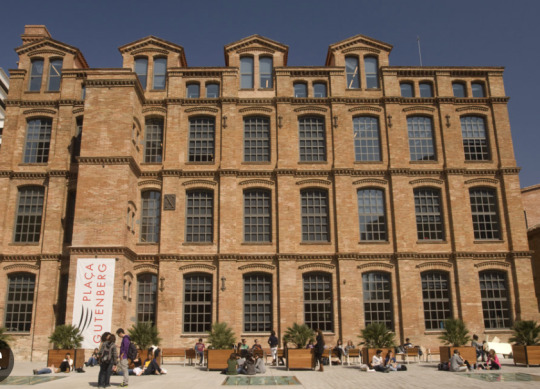
0 notes
Text
La Casa-Taller





The Casa-taller means the workshop house. On the first floor there would be the workshop with a big window and small door. The next floor is the principal floor. The owner of the workshop would live here and it would have higher ceilings and it was the nicest floor in the building. The servants would live at the top. It was the cheapest part and had the smallest windows, and a lot of stairs to get up to.
I found it very interesting how these homes were still standing after being built on such hard standards. People still were living on the very top floor, having to walk up so many stairs today, with a tiny balcony and tiny window.
0 notes
Text
Streets dedicated to craftmanship/trades








What are the ElsGremis? The guilds. There were different guilds such as Agullers (needle makers), boters (cask makers), brocaters (brocade makers), corders (rope spinners). There are a lot of different guilds for different functions. The blacksmiths are known as the most important guild and it was cool to see the sign on the street preserved.
Pictured above:
Cous Cous Street: We learned how it was a street where everyone was selling cous cous everywhere. It was sad to see a lot of the businesses on this street to be out of business. On this street we saw one of the few remaining blacksmith signs which was really cool to see.
Placa de la llana: We talked about how the wool market was an important part in this plaza where a lot of people would come to trade wool.
Placa de les candeles: Here, we saw the sign for the people having problems with drugs on this street... It was the plaza of candles.
Carrer dels cotoners: On this street was the street of cotton. We saw the corners of the streets to allow horses to be able to come by on the narrow street.
Carrer dels banys vells: The street where the women would do the laundry. It is crazy to me how they would all bring their laundry there to be done before washing machines were invented.
0 notes
Text
Typical Roman House or Domus Terms:
The Culina in a typical Roman House or Domus is the kitchen. In catalan it is cuina, and culinaria means cooking.
The Peristylum is an outdoor open area surrounded by pillars. Also known as a courtyard. It was used for social activities.
The atrium is in the center of the Roman house, it is the central area that the house is based off of. In the middle of the atrium there is typically a fountain that collects water from the open roof.
The triclinium is the dining room in a Roman house. It is known as the most important room.
The tablinum is typically next to the entrance of the house and an office for the father of the house.
0 notes
Text
Visigothic influence
The Visigothic influence in the museum was found under a pile under the cathedral, through the tunnel where the first christians were baptized. In the Baptisteri there was the first Visigothic Baptism Pool. This pool was at the end of the museum and it was very cool to see the remains. I have learned that Baptism is very important for the Christianity religion. Starting in the 6th century, the pool was made into a shape that had a cross in it. It started in a square and then was made into an octagon and then finally added in the cross through the steps.

0 notes
Text
Images and Gods related to Food and Wine in Roman times
One of the gods we learned about in class was Dionisio Baco. As you can see there are grapes on his head relating to wine. Greeks were the first to celebrate wine, and to show naked people in statues. Wine became the blood of Jesus and became sacred for Christianity. He was known for the God of agriculture and wine, losing temper, and the god of drama. Primarily, associated with drinking. Another goddess was Minerva, the statue of liberty was based off of her and she was the goddess of war.
Today, food and wine is important in socialization and understanding human needs. You understand who they are at the table with them. Two popular Catalan wine brands today are Cava and Vermouth. I am looking forward to trying them while I am here in Barcelona. Cava I have learned is similar to champagne.



0 notes
Text
Domestic Objects
There were a few objects that are similar to the objects today including; scissors, makeup and tic tac toe.There were also personal ornaments, fibulae, rings and hairpins. The rings look somewhat similar to what people wear today. The hair pins do look very different as they look as if they are dated. Another case had a games table, dice and tokens. The dice have the same concept as today and definitely could be used in some games and we would understand how to use them. However, the domestic and children objects look completely different. The spoons have a much skinnier end and a bigger circle at the top.
The object that surprised me the most was the dice. I never realized how old they are and how they haven’t evolved much from the Roman times.

0 notes
Text
Construction similarities and decorative arts

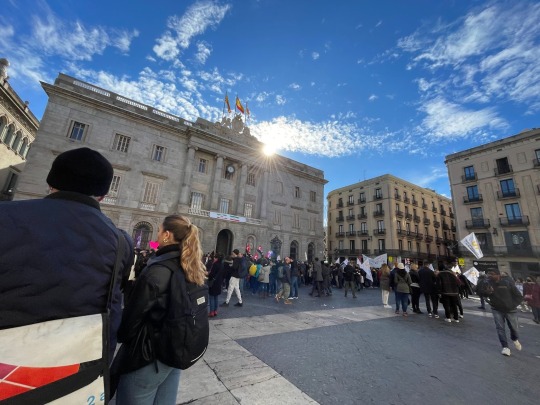

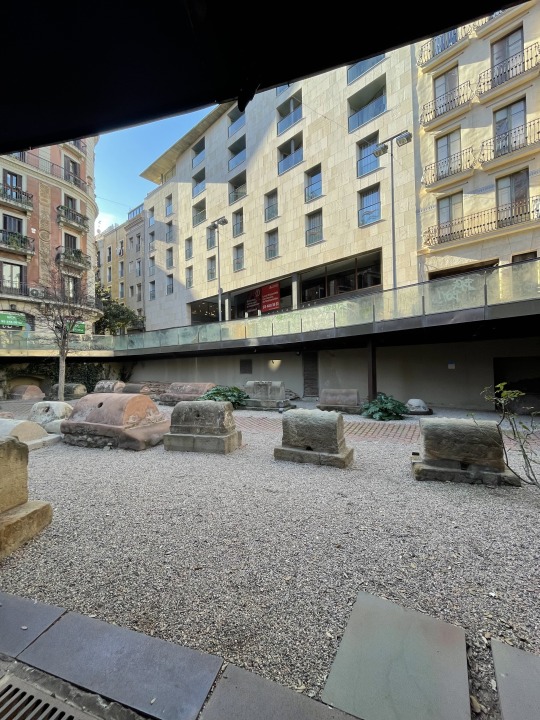

The Catedral is not an original building however, it was designed to look as if it was from the gothic times of Barcelona. It is a good example of how the city preserves the past and present. You can see the difference in materials combining the different construction.
In the Plaza sant Jaun we saw the political center and how everything was in a square. It had both the government and the ajuntament of Barcelona.
The aqueduct in the plaza de la Catedral shows the combination of the old and new construction of the medieval times.
The roman Necropolis was also a cool stop and behind it you can see how the building was half modern and half medevial.
Lastly, the columns in Temple d’August shows how the construction was preserved and then an apartment was made out of it. It is a very pretty area to observe the history and combined with a living complex.
The construction similarities show a lot of curves and columns in a lot of the main buildings. You can see the mixture of both modern and gothic buildings in the gothic quarter. I would also say a lot of the buildings seen are symmetrical such as the Cathedral and the government buildings.
In the United States, there is some preserving of old buildings and adding new to them. Especially in D.C. where I am from there are definitely older parts of the city and then new modern buildings coming in on top. Some of the architecture in the United States could have some of the same ideas as the Catalan buildings but I find the two to be somewhat different.
0 notes
Text
Roman Religious Artifacts



These 3 artifacts show some importance towards the Christainity religion.
Christianity went from Polytheism to Monotheism, Polytheism meaning worshipping multiple gods, and then Monotheism meaning one god. Now Christainity is monotheism.
The change and cultural meaning of these religious artifacts show how they are still important to the Christianity religion, however, today there are new artifacts as well that Christianity honors.
If you click on the photos, you can see the captions to the photos!
0 notes
Text
Roman Monumental Influence and Engineering Capacity





In the Gothic Quarter, there is a lot of Roman Influence seen throughout the city. Especially in the museum, I was able to learn about some of the basics such as walls, roads and the defensive road system.
While walking throughout Catalan buildings today, you can see the influence such as the old walls and the new modern walls built on top. For example, the aqueduct by the Cathedral you can see the two different types of walls built on top of eachother. One looking like the wall seen in the last photo and the one on top being more modern. Also, on the streets you can see the old water fountains systems that were used that are still here today. The fountains do look dated, as today there is a newer system for the water flow through the city.
If you click on the photos, you can see the captions to the photos!
0 notes
Text
Blog Post #1: The Roman Origins
My first field study for Catalan Culture Studies was in the Gothic Quarter of Barcelona. This was my first time visiting the gothic quarter and I was very intrigued by the remains of the gothic quarter and how well preserved and well kept it was. We started at the Portal del ángel and learned it was the start of the gothic quarter and it was so cool to see the difference between the new and old city. We then saw the Plaza de la Catedral and I was amazed by the architecture and how the aqueduct was still partially intact. Following this we saw where our field study was at the Barcelona History museum. We also walked through the other parts of the quarter seeing carrer del Bisbe, Plaza San Felipe, Plaza sant Juan and carrer paradis.
0 notes